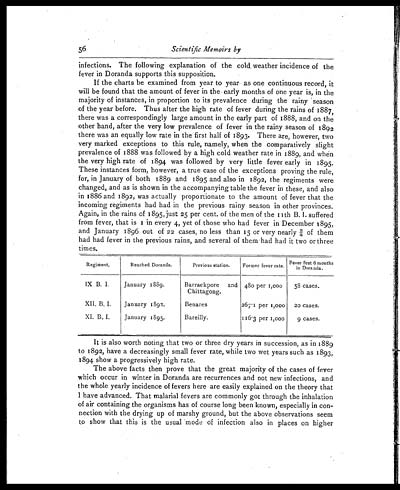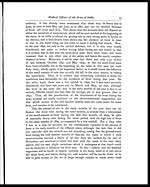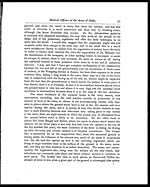Medicine - Institutions > Army health reports and medical documents > Scientific memoirs by medical officers of the Army of India > Part X, 1897 > 3 - On the influence of variations of the ground-water level on the prevalence of malarial fevers
(74) Page 56
Download files
Individual page:
Thumbnail gallery: Grid view | List view

56
Scientific Memoirs by
infections. The following explanation of the cold weather incidence of the
fever in Doranda supports this supposition.
If the charts be examined from year to year as one continuous record, it
will be found that the amount of fever in the early months of one year is, in the
majority of instances, in proportion to its prevalence during the rainy season
of the year before. Thus after the high rate of fever during the rains of 1887,
there was a correspondingly large amount in the early part of 1888, and on the
other hand, after the very low prevalence of fever in the rainy season of 1892
there was an equally low rate in the first half of 1893. There are, however, two
very marked exceptions to this rule, namely, when the comparatively slight
prevalence of 1888 was followed by a high cold weather rate in 1889, and when
the very high rate of 1894 was followed by very little fever early in 1895.
These instances form, however, a true case of the exceptions proving the rule,
for, in January of both 1889 and 1895 and also in 1892, the regiments were
changed, and as is shown in the accompanying table the fever in these, and also
in 1886 and 1892, was actually proportionate to the amount of fever that the
incoming regiments had had in the previous rainy season in other provinces.
Again, in the rains of 1895, just 25 per cent. of the men of the 11th B. I. suffered
from fever, that is 1 in every 4, yet of those who had fever in December 1895,
and January 1896 out of 22 cases, no less than 15 or very nearly 3/4 of them
had had fever in the previous rains, and several of them had had it two or three
times.
| Regiment. | Reached Doranda. | Previous station. | Former fever rate. | Fiver first 6 month in Doranda. |
| IX B. I. | January 1889. | Barrackpore and Chittagong. |
480 per 1,000 | 58 cases. |
| XII. B. I. | January 1892. | Benares | 267·1 per 1,000 | 20 cases. |
| XI. B. I. | January 1895. | Bareilly. | 116.3 per 1,000 | 9 cases. |
It is also worth noting that two or three dry years in succession, as in 1889
to 1892, have a decreasingly small fever rate, while two wet years such as 1893,
1894 show a progressively high rate.
The above facts then prove that the great majority of the cases of fever
which occur in winter in Doranda are recurrences and not new infections, and
the whole yearly incidence of fevers here are easily explained on the theory that
I have advanced. That malarial fevers are commonly got through the inhalation
of air containing the organisms has of course long been known, especially in con-
nection with the drying up of marshy ground, but the above observations seem
to show that this is the usual mode of infection also in places on higher
Set display mode to: Large image | Zoom image | Transcription
Images and transcriptions on this page, including medium image downloads, may be used under the Creative Commons Attribution 4.0 International Licence unless otherwise stated. ![]()
| Permanent URL | https://digital.nls.uk/75003270 |
|---|
| Shelfmark | IP/QB.10 |
|---|---|
| Additional NLS resources: | |




